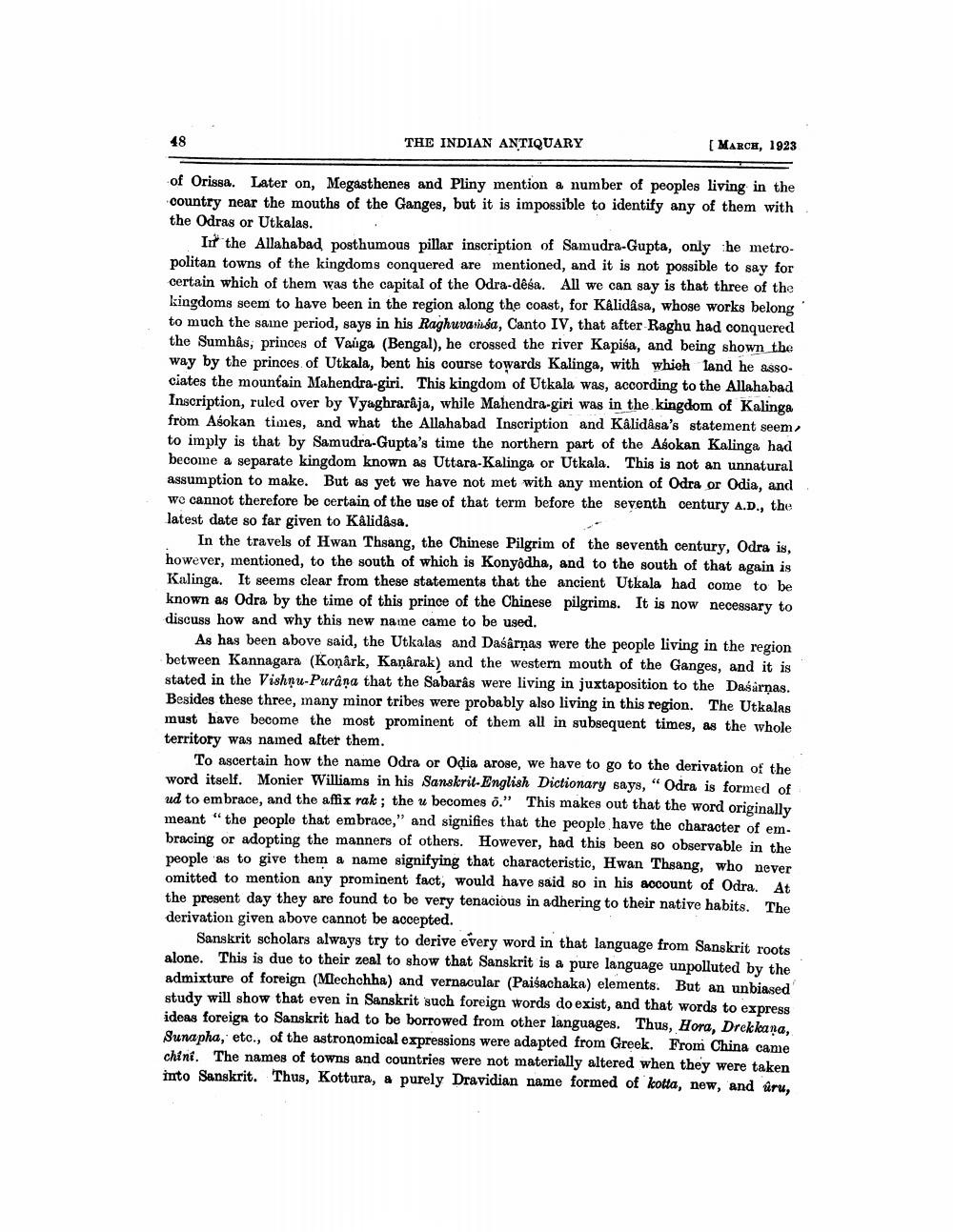________________
48
THE INDIAN ANTIQUARY
[ MARCE, 1923
of Orissa. Later on, Megasthenes and Pliny mention a number of peoples living in the country near the mouths of the Ganges, but it is impossible to identify any of them with the Odras or Utkalas.
In the Allahabad posthumous pillar inscription of Samudra-Gupta, only he metropolitan towns of the kingdoms conquered are mentioned, and it is not possible to say for certain which of them was the capital of the Odra-desa. All we can say is that three of the kingdoms seem to have been in the region along the coast, for Kalidasa, whose works belong to much the same period, says in his Raghuvassa, Canto IV, that after Raghu had conquered the Sumhâs, princes of Vaiga (Bengal), he crossed the river Kapisa, and being shown the way by the princes of Utkala, bent his course towards Kalinga, with which land he associates the mountain Mahendra-giri. This kingdom of Utkala was, according to the Allahabad Inscription, ruled over by Vyaghrarâja, while Mahendra-giri was in the kingdom of Kalinga from Asokan times, and what the Allahabad Inscription and Kalidasa's statement seem to imply is that by Samudra-Gupta's time the northern part of the Asokan Kalinga had become a separate kingdom known as Uttara-Kalinga or Utkala. This is not an unnatural assumption to make. But as yet we have not met with any mention of Odra or Odia, and we cannot therefore be certain of the use of that term before the seventh century A.D., the latest date so far given to Kalidasa.
In the travels of Hwan Thsang, the Chinese Pilgrim of the seventh century, Odra is, however, mentioned, to the south of which is Konyôdha, and to the south of that again is Kalinga. It seems clear from these statements that the ancient Utkala had come to be known as Odra by the time of this prince of the Chinese pilgrims. It is now necessary to discuss how and why this new name came to be used.
As has been above said, the Utkalas and Dasarņas were the people living in the region between Kannagara (Konark, Kanârak) and the western mouth of the Ganges, and it is stated in the Vishnu-Purâņa that the Sabarâs were living in juxtaposition to the Daśårņas. Besides these three, many minor tribes were probably also living in this region. The Utkalas must have become the most prominent of them all in subsequent times, as the whole territory was named after them.
To ascertain how the name Odra or Odia arose, we have to go to the derivation of the word itself. Monier Williams in his Sanskrit-English Dictionary says, “ Odra is formed of ud to embrace, and the affix rak; the u becomes 7." This makes out that the word originally meant "the people that embrace," and signifies that the people have the character of em. bracing or adopting the manners of others. However, had this been so observable in the people as to give them a name signifying that characteristic, Hwan Thsang, who never omitted to mention any prominent fact, would have said so in his account of Odra. At the present day they are found to be very tenacious in adhering to their native habits. The derivation given above cannot be accepted.
Sanskrit scholars always try to derive every word in that language from Sanskrit roots alone. This is due to their zeal to show that Sanskrit is a pure language unpolluted by the admixture of foreign (Mlechchha) and vernacular (Paisachaka) elements. But an unbiased study will show that even in Sanskrit such foreign words do exist, and that words to express ideas foreign to Sanskrit had to be borrowed from other languages. Thus, Hora, Drekkana. Sunapha, etc., of the astronomical expressions were adapted from Greek. From China came chini. The names of towns and countries were not materially altered when they were taken into Sanskrit. Thus, Kottura, a purely Dravidian name formed of kotta, new, and úru,




